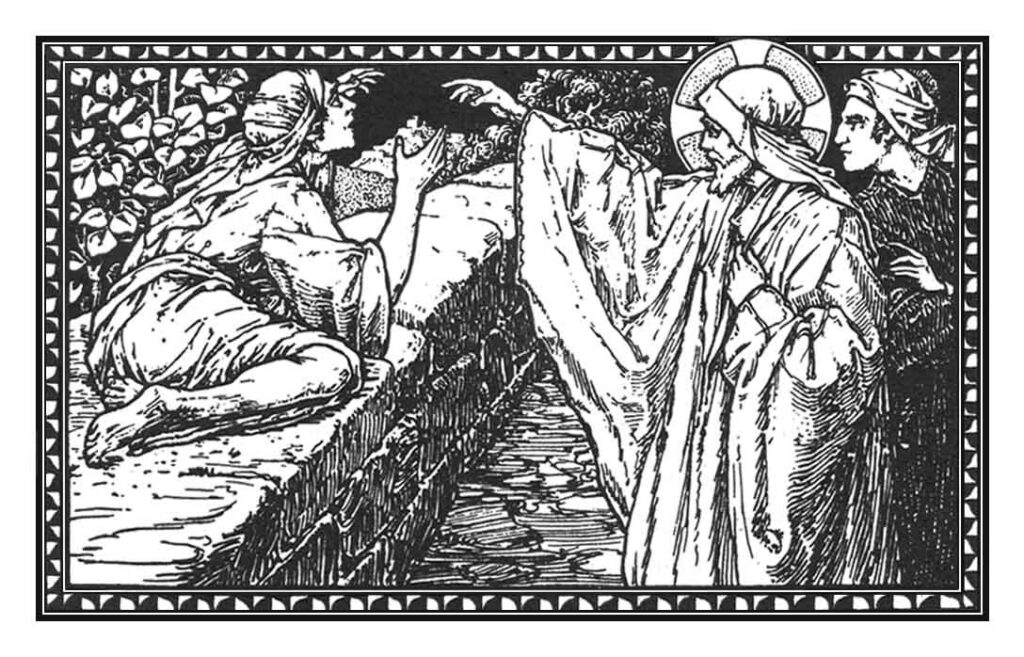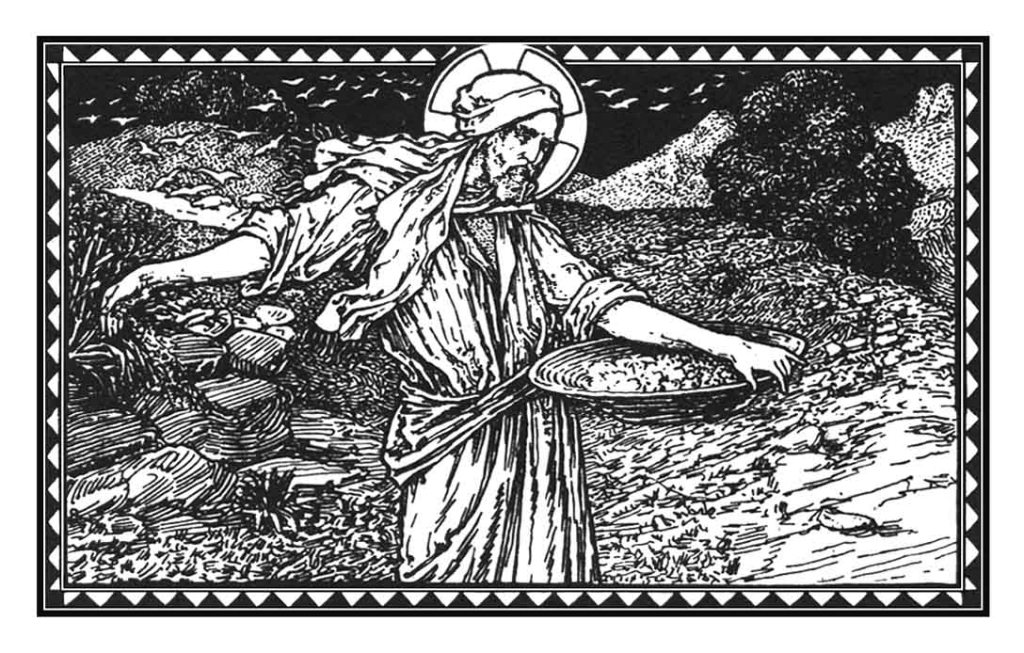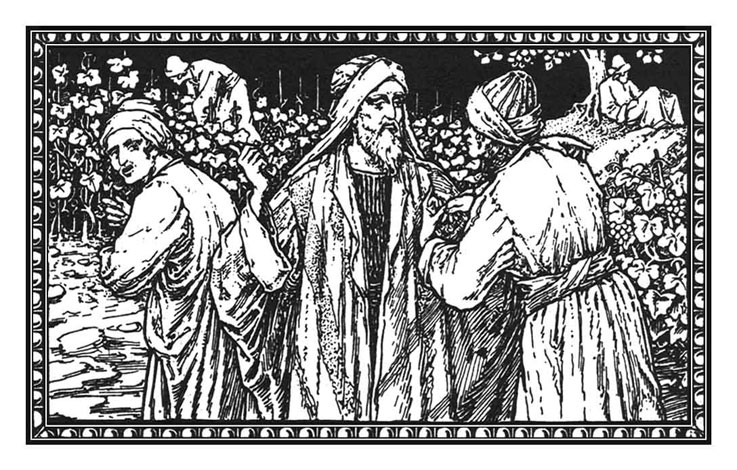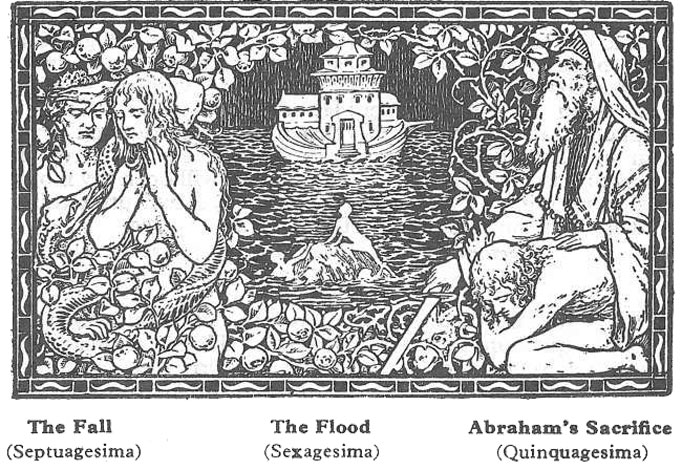Season of Septuagesima
Quinquagesima Sunday

On Quinquagesima Sunday, in the Epistle, the Church places before us the three virtues which we are to work on during the forty days of Lent. St. Paul in his Epistle to the Corinthians says, “There are three virtues, faith, hope, and charity, these three; but the greatest of these is charity.”
The penances which the Church encourages her children to perform during the forty days of Lent, namely prayer, fasting, and almsgiving, free the soul to believe, to hope, and to love God. It does this because these three penances of prayer, fasting, and almsgiving detach us from the things in which we would otherwise put our faith, hope, and love.
At Matins during this week is read the history of Abraham, the “father of true believers”. St. Peter, in whose basilica the Station is held, deserves the same title to a higher degree.
The man born blind, of whom the Gospel tells, is a type of the human race, turned out of Paradise and plunges in the darkness of condemnation.
Jesus, by the merits of His passion, is to open the eyes of men as He did those of the blind man of Jericho, and to give them the light of faith. But faith, of which St. Paul speaks, is as naught without charity (Epistle). The merits of our works, as well as the light which illumines our souls, are in proportion to our charity.
If it is of liturgical origin to grant our souls some relaxation before undertaking the Lenten penance which is imposed on all, let us not forget that the Church condemns all excesses; and for the expiation of such as are committed, let us join in the Forty Hours prayers which Pope Clement XIII (1765) has endowed with many indulgences.
Sexagesima Sunday

The sexagesima liturgy may be represented in a triptych.
In the center, Jesus, in a boat, on the shores of the Lake of Galilee preaches the Parable of the Sower (Gospel). It is the Redeemer who by His saving doctrine gives life to souls (Collect).
On the left, Noah’s ark floats on the waters of the flood (Matins). It contains the family which is to repopulate the world with believing souls. In the Matins of this week, Noah’s history is read.
On the right, St. Paul faces shipwreck and “the perils in the sea” (Epistle) in order that all nations (Collect) may hear the life-giving word of Christ. The Station being at St. Paul-without-the-Walls his memory occupies a large place in this Mass.
Septuagesima Sunday

In the Matins of this week, the history of Adam and Eve is read. Man, who is victim of the sin of Adam and of his own, “is justly afflicted” (Collect), “groans and sorrows encompass him” (Introit). Hence St. Paul compares life to an arena where we must fight and mortify ourselves if we wish to obtain the victory (Epistle).
The Gospel in turn shows us that we must all work to obtain the reward, which is eternal life.
The master of the vineyard goes out at all hours. “The morning,” says St. Gregory, “is the period that elapsed from the time of Adam to Noah, the third hour from Noah to Abraham, the sixth hour from Abraham to Moses, the ninth hour from Moses to the coming of the Lord, and at the eleventh hour the Gentiles are called.”
Israel has not answered the call (Epistle)…the Gentiles, the laborers of the last hour, were given the higher place (Gospel).
Septuagesima

The Septuagesima season always begins with the ninth week before Easter and includes three Sundays called respectively Septuagesima, Sexagesima, and Quinquagesima. These names which were borrowed from the numeral system of the time, denote a series of decades working back from the commencement of Lent, which is known in Latin as Quadragesima. [As the intervals between these Sundays only consist of seven days it is evident that this name must not be taken in a strictly arithmetical sense; but whereas Quadragesima comes exactly at the closing day of the 4th decade before Easter, Quinquagesima (47 days) falls within the 5th decade, Sexagesima (54 days) within the 6th, Septuagesima (61 days) within the 7th.]
This liturgical period is a prelude to Lent and a remote preparation for Easter. It serves as a time of transition for the soul, which must pass from Christmas joys to the stern penance of the sacred forty days. Even if the fast is not yet of obligation, the color of the vestments worn is already violet. As during Advent, the recital of the Gloria in excelsis is suspended, since this hymn which celebrated Christ’s birth in our mortal flesh, is reserved to extol Him when born in His undying Body, i.e. when He rises from the tomb. “Born once of the Virgin, thou art now reborn from the sepulchre,” will then be the cry of the Church. Again the Martyrology introduces Septuagesima Sunday as that on which “we lay aside the song of the Lord which is Alleluia.” “How,” said the people of Israel, “shall we sing the song of the Lord in a strange land?”
This “strange land” is for the people of Christ, the world, which is a place of exile, while Alleluia, the chant St. John heard in heaven, will begin again in the liturgy at Paschaltide, which represents the future life. In the Easter festivities we shall hail our Lord, the conqueror of Satan, who while freeing us from the bondage of sin, will re-open to us the heavenly kingdom. The season of Lent which lasts for forty days (Quadragesima) and that of Septuagesima which is made up of the following periods of ten days (Quinquagesima, Sexagesima, and Septuagesima) may well be taken as representing the seventy years passed by Israel in exile under the harsh captivity of the Babylonians. The chant of Alleluia is silent during this period in which the spirit and very name remind us so strongly, that we are “poor banished children…mourning and weeping in this vale of tears” (Salve Regina).
The Season of Septuagesima ends in the Temporal Cycle on Ash Wednesday. In the Sanctoral Cycle its extreme limit is March 10, that is, when Easter falls on April 25.